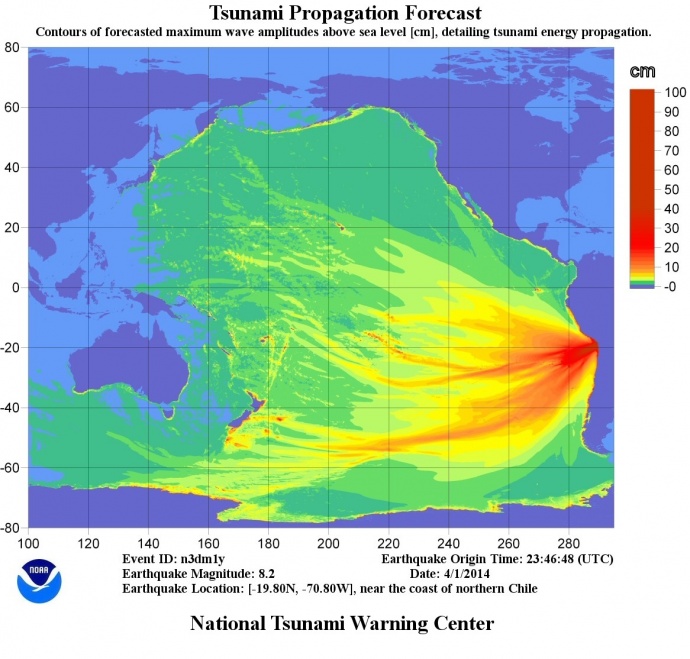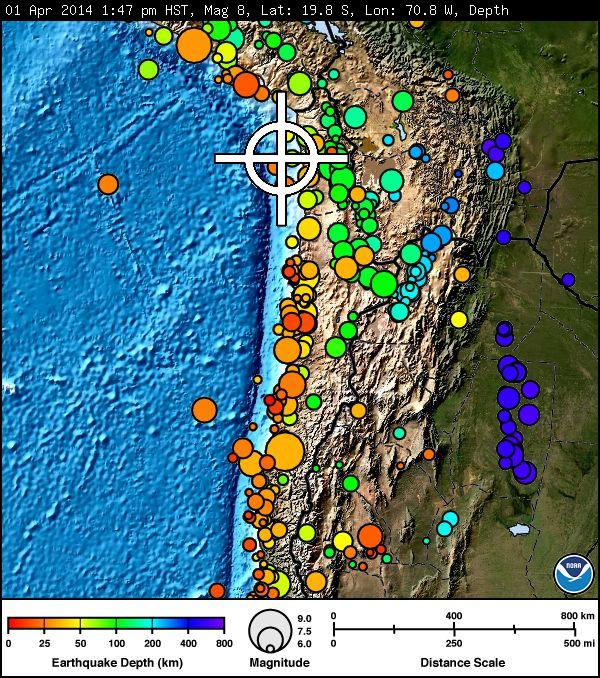Tsunami Advisory Cancelled, 1.7′ Waves Recorded at Kahului
By Wendy Osher
(UPDATE: 8:30 a.m. 4/2/14; Update: 7:25 a.m. 4/2/14)
The Pacific Tsunami Warning Center cancelled the tsunami advisory for Hawaiʻi at 7:25 a.m. on Wednesday, April 2, 2014.
Civil Defense authorities in Hawaiʻi say no damage has been reported, and emergency personnel reported minimal wave activity.
According to the update, tsunami wave heights across the state of Hawaiʻi are now below advisory levels and are continuing to diminish.
Based on all available data, the Pacific Tsunami Warning Center is now cancelling the tsunami advisory.
“Smaller sea level changes and strong or unusual currents may persist for several additional hours and appropriate caution should be exercised by boaters and swimmers,” agency officials said.
Ocean Safety officials also completed an assessment of conditions as of 8:30 a.m., and report nothing unusual. All Maui County beach parks are now open.
The event generated wave activity of 1.9 feet in Hilo on Hawaiʻi Island earlier this morning, and 1.7 feet at Kahului Harbor on Maui with waves coming in at 18 minute intervals.
Again, the tsunami advisory is cancelled as of 7:25 a.m. HST on Wednesday, April 2, 2014.
The advisory was initially issued following an 8.2 magnitude earthquake reported at 1:47 p.m. HST on Tuesday, April 1, 2014, off the coast of Northern Chile.
“Mahalo to our local emergency personnel and all those that came together following the Chile earthquake yesterday,” said Doug Mayne, vice director of the state Civil Defense agency in a press release statement.
“We would also like to extend our sympathy to those affected by the earthquake in Chile and remind our beachgoers, boaters and other ocean users to continue to follow instruction from ocean safety personnel,” said Mayne.
(Update: 6:34 a.m. 4/2/14; Past Updates: 5:33 a.m., 4:44 a.m., 3:30 a.m. 4/2/14)
A tsunami advisory remains in effect for the state of Hawaiʻi, according to an updated report issued by the Pacific Tsunami Warning Center at 6:34 a.m. on Wednesday, April 2, 2014.
The advisory comes following an 8.2 magnitude earthquake reported at 1:47 p.m. HST on Tuesday, April 1, 2014, off the coast of Northern Chile.
Beaches on Maui remain closed until noon today, but may be open earlier if conditions warrant.
Measurements or reports of tsunami wave activity as monitored by the Pacific Tsunami Warning Center show the greatest wave activity in Hilo on the Big Island of Hawaiʻi where wave amplitude was measured at 1.9 feet with 16 minute intervals between waves.
In Kahului, Maui, wave activity was 1.7 feet with 18 minute intervals between waves. The measurements are lower than the crest-to-trough values for wave heights being reported by some other news outlets.
The latest list of measurements by the Pacific Tsunami Warning Center (updated as of 6:34 a.m. 4/2/14) include the following:
Gauge Location Lat Lon Time Amp Per
——————- —– —— —– ————— —–
Aoua Upolu Western Samoa: (13.8S 171.8W) 6:13 a.m., 0.09 meters or 0.3 feet, 14 minutes;
Pago Pago American Samoa: (14.3S 170.7W) 5:38 a.m., 0.31 meters or 1.0 feet, 18 minutes;
Barbers Point, HI: (21.3N 158.1W) 4:28 a.m., 0.03 meters or 0.1 feet, 22 minutes;
Kahului Maui: (20.9N 156.5W) 5:14 a.m., 0.52 meters or 1.7 feet, 18 minutes;
Waiʻanae HI: (21.4N 158.2W) 5:03 a.m., 0.06 meters or 0.2 feet, 12 minutes;
Hanalei HI: (22.2N 159.5W) 4:34 a.m., 0.08 meters or 0.3 feet, 14 minutes;
Nāwiliwili HI: (22.0N 159.4W) 4:22 a.m., 0.02 meters or 0.1 feet, 24 minutes;
Haleiwa HI: (21.6N 158.1W) 4:26 a.m., 0.11 meters or 0.4 feet, 14 minutes;
Hilo HI: (19.7N 155.1W) 4:38 a.m., 0.58 meters or 1.9 feet, 16 minutes;
Honuʻapo HI: (19.1N 155.6W) 4:36 a.m., 0.04 meters or 0.1 feet, 8 minutes;
Honokōhau HI: (19.7N 156.0W) 4:05 a.m., 0.06 meters or 0.2 feet, 12 minutes;
Kapoho HI: (19.5N 154.8W) 3:42 a.m., 0.13 meters or 0.4 feet, 14 minutes.
LAT – Latitude (N-North, S-South)
LON – Longitude (E-East, W-West)
TIME – Time of the Measurement
AMPL – Tsunami amplitude measured relative to normal sea level. It is not crest-to-trough wave height. Values are given in both meters and feet.
PER – Period of time in minutes from one wave to the next.
Earlier measurements from 5:33 a.m. 4/2/14 report:
Pago Pago American Samoa: (14.3S 170.7W) 5:11 a.m., 0.14 meters or 0.5 feet, 20 minutes;
Kahului Maui: (20.9N 156.5W) 5:14 a.m., 0.52 meters or 1.7 feet, 18 minutes;
Waiʻanae, HI: (21.4N 158.2W) 5:03 a.m., 0.06 meters or 0.2 feet, 12 minutes;
Hanalei, HI: (22.2N 159.5W) 4:34 a.m., 0.08 meters or 0.3 feet, 14 minutes;
Nāwiliwili, HI: (22.0N 159.4W) 4:22 a.m., 0.02 meters or 0.1 feet, 24 minutes;
Haleʻiwa, HI: (21.6N 158.1W) 4:26 a.m., 0.11 meters or 0.4 feet, 14 minutes;
Hilo, HI: (19.7N 155.1W) 4:38 a.m., 0.58 meters or 1.9 feet, 16 minutes;
Honuʻapo, HI: (19.1N 155.6W) 4:36 a.m., 0.04 meters or 0.1 feet, 8 minutes;
Honokōhau, HI: (19.7N 156.0W) 4:05 a.m., 0.06 meters or 0.2 feet, 12 mintues;
Kapoho, HI: (19.5N 154.8W) 3:42 a.m., 0.13 meters or 0.4 feet, 14 minutes.
Earlier measurements from 4:44 a.m. 4/2/14 report:
Kahului Maui: (20.9N 156.5W) 4:08 a.m., 0.26 meters or 0.9 feet, 20 min;
Hilo, Hawaiʻi: (19.7N 155.1W) 4:07 a.m., 0.55 meters or 1.8 feet, 16 min;
Honokōhau, HI: (19.7N 156.0W) 4:05 a.m., 0.06 meters or 0.2 feet, 12 min;
Honuʻapo, HI: (19.1N 155.6W) 3:47 a.m., 0.04 meters or 0.1 feet, 16 min;
Kapoho, HI: (19.5N 154.8W) 3:42 a.m., 0.13 meters or 0.4 feet, 14 min.
(UPDATE: 3:01 a.m. 4/2/14; Original Update: 5:48 P.M. 4/1/14)
A tsunami advisory was issued for the state of Hawaiʻi, according to an updated report issued by the Pacific Tsunami Warning Center at 5:46 p.m. on Tuesday, April 1, 2014.
According to the agency, a major tsunami is not expected to strike the state, however sea level changes and strong currents may occur along all coasts that could be a hazard to swimmers and boaters, as well as to persons near the shore at beaches and in harbors and marinas.
Officials from the agency say the threat may continue for several hours after the initial wave of arrival. The earliest estimated arrival of tsunami waves is at 3:38 a.m. HST on Wednesday, April 2, 2014, according to updated information issued by the Maui County Civil Defense Agency (3:24 a.m. HST according to the Pacific Tsunami Warning Center).
The advisory comes following an 8.2 magnitude earthquake reported at 1:47 p.m. HST on Tuesday, April 1, 2014, off the coast of Northern Chile.
Maui County Civil Defense authorities say beaches will be closed until 12 p.m. (noon) on Wednesday, April 2, 2014. Maui County Civil Defense Administrator Anna Foust said that if conditions warrant, beaches may open earlier.
“Throughout this tsunami advisory, we are in close contact with State Civil Defense, local emergency personnel and all state departments,” said Gov. Neil Abercrombie in a statement. “With April being Tsunami Awareness Month in Hawaiʻi, this is a timely reminder that we all need to be prepared and have emergency plans and kits ready.”
Additional Information From the US Coast Guard for Mariners:
The Coast Guard is advising the public to remain vigilant of hazardous currents and tidal surges following the Chile earthquake. The Coast Guard advises all mariners to ensure that their vessels are secured for possible changes in sea conditions. Updated weather conditions will be broadcast on VHF channel 16.
(UPDATE: 4:47 p.m. 4/1/14; Original post: 2 p.m. 4/1/14)
The Pacific Tsunami Warning Center is still evaluating a magnitude 8.2 earthquake (magnitude was revised upward from an earlier 8.0 estimate) reported at 1:47 p.m. HST on Tuesday, April 1, 2014, off the coast of Northern Chile.
An evaluation of the Pacific was still underway as of 4:47 p.m. on 4/1/14, and there is a possibility that Hawaiʻi could be elevated to a watch or warning status, according to the Pacific Tsunami Warning Center.
If tsunami waves impact Hawaiʻi, the agency says the earliest estimated arrival is 3:24 a.m. HST on Wednesday, April 2, 2014.
Further statements will be issued hourly or sooner as conditions warrant until the threat to Hawaiʻi has passed.
The agency issued an information statement saying an expanding regional tsunami warning and watch was issued for parts of the Pacific located closer to the quake.
Currently, there is a tsunami warning in effect for Chile and Peru according to updated information released by the Pacific Tsunami Warning Center. Other areas that were under watches and warnings have since been cancelled.
The quake was located 59 miles NW of Iquique, Chile; 86 miles SSW of Arica, Chile; 118 miles SSW of Tacna, Peru; 142 miles SSE of Ilo, Peru; and 278 miles SW of La Paz, Bolivia, according to the US Geological Survey. The agency says the quake occurred at a depth of between 6 and 12.5 miles.
Below are some helpful links to prepare in case of a tsunami event:
- To find out if you live in a tsunami evacuation zone, Hawaii residents can visit the following DIRECT LINK.
- To find out what tsunamis are and what causes them follow this LINK.
- What do I do before a tsunami LINK.
- Supply list for building a preparedness kit LINK.
- How much water do I need LINK.
- What do I do after a tsunami LINK.
- What should I do if I am a boater LINK.











